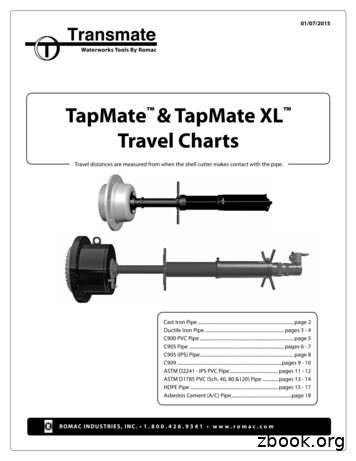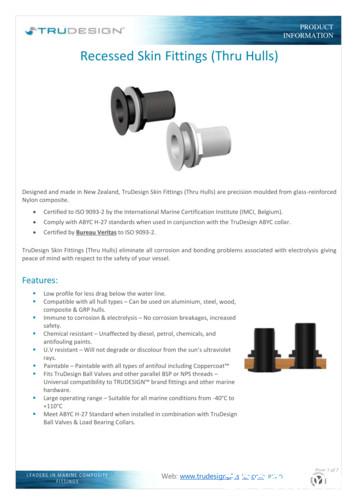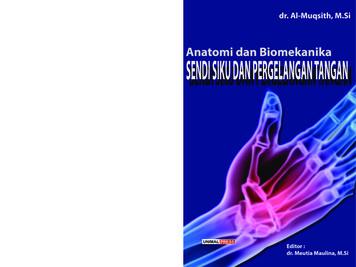Thru-Hull Chirp Transducers AIRMAR
THRU-HULLThru-Hull Chirp TransducersUnlock the true potential of your fishfinder with the superior quality andperformance of an AIRMAR Chirp-ready transducer.B265LH screenshot courtesy of FurunoThe Benefits of AIRMAR’s Chirp-ready Transducers One broadband transducer covers up to 117 kHz of bandwidth – greater opportunities to detect fish in thewater columnSuperior resolution – precise separation between baitfishand gamefish represented on the display with crispimagesEnhanced bottom fishing – resolve targets close to thebottom or near structure/wrecksAmazing detail – recognize haloclines and thermoclinesImproved signal to noise ratio – find fish and track bottomat high boat speedsAIRMAR , DEFINING CHIRP TECHNOLOGY.Benefits of Thru-Hull Transducerswith High Performance FairingThru-hull installations provide best performance comparedwith other installation options for many reasons. The best performance on vessels 25 feet and up becausethe transducer face is in “clean” water below theboundary layer (bubbles running down the hull) The fairing compensates for hull deadrise and reducesturbulence over the transducer face, which allowstracking at speeds over 30 knots (35 MPH) When mounted in clean water (forward of propellersand running gear), thru-hulls produce the most effectivesignal return since nothing on the vessel interferes withthe transducer’s active surface
Why does frequency matter?High Frequency Greater Detail (ex. 130-210 kHz)Selecting the best frequency for your specific applicationis very important. The good news is that once you knowwhat frequency will work best for the type of fishing youdo, there’s an AIRMAR transducer designed to maximize theperformance of your sounder. More sensitive to small targets and will send back detailedinformation which will display as crisp, high-resolutionimages on the echosounder screen Best for shallower water and popular with anglers fishingat depths less than 1500 feetAIRMAR Chirp transducers are available in various frequencyc ombinations: Dual Band: Single Band:ūū Low/High (LH)ūū Lowūū Low/Medium (LM)ūū Mediumūū Low/High Wide (LHW)ūū Highūū Low Wide/Medium (LWM)ūū High WideMedium Frequency The Best of Both Worlds(ex. 80-130 kHz) Provides the ability to sound deeper than the highfrequency, along with better resolution than thelow frequency Wider beam than the high frequency, achieving morecoverage under the boat and greater opportunity to find fish Clear images at higher boat speedsLow Frequency Greater Depth (ex. 42-65 kHz) Sound waves will not present as clear a picture of thebottom on the display, but will sound down in very deepareas where high frequency sound waves cannot reach Provides greater depth range, wider beamwidth, andultimately more coverage under the boat Chirp signal processing technology used with AIRMARbroadband, Chirp-ready transducers provides more detailat greater depths and is less susceptible to noise Great for operating at high boat speeds1 kWMax depth 3000'0'2 kWMax depth 6000'HIGHWIDEHIGHWIDEHIGHMED2-3 kWMax depth 6000'LOW8000'LOW10000'
Thru-Hull1 kW1”-11 1/2 NPSø 69 mm(2.75”)67 mm(2.65”) Depth & fast-response water-temperature sensor114 mm(4.50”)Features:178 mm(7.00”)216 mm (8.50”) Bronze transducer housing with High-Performance Fairing Hull Type: Fiberglass or wood245 mm(9.65”)ø 33 mm(1.30”) For use on hulls up to 20 deadrise8-InternalBroadband CeramicAssemblies133 mm(5.25”) Engine Type: Inboard, Outboard or I/O130 mm(5.13”)198 mm (7.80”) Boat Size: 8 m (25’) and above568 mm (22.35”)WIDEBEAMB265LHB265LMLow & Medium FrequencyLow & High Wide Frequency Low– 42 kHz to 65 kHz Low– 42 kHz to 65 kHz Low– 42 kHz to 65 kHzLow & High Frequency25 to 16 beamwidthMaximum depth 3000 ft High– 130 kHz to 210 kHz10 to 6 beamwidthMaximum depth 1000 ft 103 kHz of total bandwidth fromone transducer25 to 16 beamwidthMaximum depth 3000 ft Medium– 85 kHz to 135 kHz16 to 11 beamwidthMaximum depth 1500 ft 73 kHz of total bandwidthfrom one transducerBottom CoverageRelative to Frequency and DepthB275LHW25 to 16 beamwidthMaximum depth 3000 ft High– 150 kHz to 250 kHz25 constant beamwidthMaximum depth 500 ft 123 kHz of total bandwidth fromone transducer50’Beam Coverage at High FrequencyDepthB265LH130 kHz-210 kHzB265LM85 kHz-135 kHzB275LHW150 kHz-250 kHz50 ft10 ft14 ft22 ft100 ft20 ft28 ft44 ft300 ft53 ft84 ft134 ft600 ft104 ft168 ft266 ft1000 ft174 ft280 ftToo Deep1500 ftToo Deep420 ftToo Deep2000 ftToo DeepToo DeepToo DeepThis chart compares the high and medium ceramic elements inside the transducer,showing the difference in bottom coverage under the boat.The low frequency in each of these transducer models is the same (42 kHz - 65 kHz).The maximum depth range sounds to 3,000 ft.100’300’600’1000’1500’B265LH – High Frequency130 kHz-210 kHzB265LM – Medium Frequency85 kHz-135 kHzB275LHW – Wide beam Frequency150 kHz-250 kHz
Thru-Hull2 kW562 mm (22.11”)138 mm(5.41”)Features: Depth & fast-response water-temperature sensor Urethane transducer housing with High-Performance Fairing108 mm(4.25”) Boat Size: 12 m (40’) and above Hull Type: Fiberglass, wood, or metal444.5 mm (17.50”)CableStuffingtube Engine Type: Inboard, Outboard or I/O For use on hulls up to 22 deadriseBOW and CeramicAssembliesTemperature sensorULTRAR109LHR109LMLow & High FrequencyLow & Medium Frequency Low– 38 kHz to 75 kHz Low– 38 kHz to 75 kHz19 to 10 port/starboard19 to 10 port/starboard10 to 5 fore-aft beam10 to 5 fore-aft beamMax. depth 6000 ftMax. depth 6000 ft High– 130 kHz to 210 kHz Medium– 80 kHz to 130 kHz8 to 4 beam13 to 8 beamMax. depth 1500 ftMax. depth 3000 ft 117 kHz of total bandwidth 87 kHz of total bandwidthfrom one transducerfrom one transducerBottom CoverageRelative to Frequency and DepthWIDER109LHWR409LWMLow & High Wide Frequency Low & Medium Frequency Low– 38 kHz to 75 kHzLow– 40 kHz to 60 kHz40 constant beamwidthMax. depth 4000 ftMedium– 80 kHz to 130 kHz13 to 8 beamMax. depth 3000 ft70 kHz of total bandwidthfrom one transducer 19 to 10 port/starboard10 to 5 fore-aft beamMax. depth 6000 ft High– 150 kHz to 250 kHz25 constant beamMax. depth 500 ft 137 kHz of total bandwidthfrom one transducer50’100’Beam Coverage at High FrequencyDepthR109LH130 kHz210 kHzR109LM80 kHz130 kHzR109LHW150 kHz250 kHzR409LWM40 kHz60 kHz50 ft6 ft10 ft22 ft36 ft100 ft14 ft24 ft46 ft73 ft300 ft42 ft70 ft134 ft220 ft600 ft84 ft136 ft266 ft440 ft1000 ft140 ft226 ftToo Deep730 ft1500 ft210 ft340 ftToo Deep1092 ft2000 ftToo Deep456 ftToo Deep1456 ftThis chart compares the high and medium ceramic elements inside the transducer, showingthe difference in bottom coverage under the boat.Low frequency in each of these transducers models is the same (38-75 kHz) exceptthe R409LWM. This low frequency can range to 6,000 ft.300’600’1000’1500’2000’R109LH – High Frequency130 kHz-210 kHzR109LM – Medium Frequency80 kHz-130 kHzR109LHW – Wide beam Frequency150 kHz-250 kHzR409LWM – Ultra Wide Frequency40 kHz-60 kHz
Thru-Hull2-3 kW587.2 mm (23.12”)169.7 mm(6.68”)Features: Depth & fast-response water-temperature sensor Epoxy transducer housing with High-Performance Fairing114.3 mm(4.50”) Boat Size: 12 m (40’) and above Hull Type: Fiberglass, wood, or metal444.5 mm (17.50”)CableStuffingtube Engine Type: Inboard, Outboard or I/O For use on hulls up to 25 deadriseBOW BackingblockHullFairing25-InternalBroadband CeramicAssembliesTransducerTemperature sensorWIDEBEAMR509LHR509LMLow & Medium FrequencyLow & High Wide Frequency Low– 28 kHz to 60 kHz Low– 28 kHz to 60 kHz Low– 28 kHz to 60 kHzLow & High Frequency23 to 9 port/starboard11 to 5 fore-aft beamwidthMaximum depth 10000 ft High– 130 kHz to 210 kHz8 to 4 beamwidthMaximum depth 1500 ft 112 kHz of total bandwidth fromone transducer23 to 9 port/starboard11 to 5 fore-aft beamwidthMaximum depth 10000 ft Medium– 80 kHz to 130 kHz13 to 8 beamwidthMaximum depth 3000 ft 82 kHz of total bandwidthfrom one transducerR509LHW23 to 9 port/starboard11 to 5 fore-aft beamwidthMaximum depth 10000 ft High– 150 kHz to 250 kHz25 constant beamwidthMaximum depth 500 ft 132 kHz of total bandwidth fromone transducerBottom CoverageRelative to Frequency and Depth50’100’Beam Coverage at High FrequencyDepthR509LH130 kHz-210 kHzR509LM80 kHz-130 kHzR509LHW150 kHz-250 kHz50 ft6 ft10 ft20 ft100 ft14 ft24 ft46 ft300 ft42 ft68 ft132 ft600 ft84 ft136 ft264 ft1000 ft140 ft228 ftToo Deep1500 ft208 ft340 ftToo Deep2000 ftToo Deep456 ftToo Deep2500 ftToo Deep570 ftToo DeepThis chart compares the high and medium ceramic elements inside the transducer,showing the difference in bottom coverage under the boat.Low frequency in each of these transducer models is the same (28 kHz - 60 kHz).The maximum depth range sounds to 10,000 ft.300’600’1000’1500’2000’2500’R509LH – High Frequency130 kHz-210 kHzR509LM – Medium Frequency80 kHz-130 kHzR509LHW – Wide beam Frequency150 kHz-250 kHz
The Chirp AdvantageTraditional sounders operate at only two discrete frequencies – typically 50 kHz and 200 kHz. This resultsin limited depth range, resolution, and ultimately whattargets can be detected in the water column.In contrast, AIRMAR’s game-changing Chirp-ready transducers provide over 70 kHz of bandwidth. Transmitting over a wide frequency band results in agreater opportunity to detect what is in the water column.As a result, all targets detected in the entire bandwidth willbe seen on the display–even those fish holding close tothe bottom–ultimately improving target detection, detail,and range resolution.Most Chirp transducers vary their beam width as theysweep through their frequency range (low, medium, andhigh). At the lowest frequency the beam is the widest andit narrows as the frequency increases.The fish must be in the beam to be represented on the display.AIRMAR’s new wide beam Chirp transducers are the exception to this rule and have a fixed beam width ofeither 25 or 40 across the frequency band. This translatesinto even more coverage under the boat, revealing morefish in the water column than ever before.Courtesy of NavicoCourtesy of HumminbirdAdditional Mounting OptionsTank MountIn-HullPocket Mount Keel MountChoosing your mounting option depends on the design ofthe hull as well as the material it’s manufactured with, theboats intended use, and the desired level of performance.Courtesy of GarminCourtesy of RaymarineNeed Help Choosing the Right Transducer?Download the free, award-winning iNstall app! It’s agreat tool that takes the guesswork out of selecting theright transducer for your application. Based on frequency, mounting, housing, and cable options, iNstall will revealthe available option(s) and give you instant access to their specifications. Designed for iPhone,iPad and iPod smart phones and tablets running iOS 6.1 and newer.iNstallwww.airmar.com Airmar Technology CorporationThruHull Chirp BR rG 10/04/19As Airmar constantly improves its products, all specifications are subject to change without notice.All Airmar products are designed to provide high levels of accuracy and reliability, however theyshould only be used as aids to navigation and not as a replacement for traditional navigation aids andtechniques. Xducer ID is a registered trademark of Airmar Technology Corporation. Other companyor product names mentioned in this document may be trademarks or registered trademarks of theirrespective companies, which are not affiliated with Airmar.
the transducer’s active surface. THRU-HULL. B265LH screenshot courtesy of Furuno. AIRMAR , DEFINING CHIRP TECHNOLOGY. Thru-Hull Chirp Transducers. Unlock the true potential of your fishfinder with the superior quality and . performance of an AIRMAR Chirp-ready transducer.
Heading adjust Tuning reference Zero range/timing Sensitivity Echo setup Transducer Depth Frequency . Airmar B250 ECHO2 Airmar Combi B250-22 Airmar B260 ECHO2 Airmar Combi B250-22 Airmar P319, P52, P66, B117, B45, . Transducers containing speed log sensor e.g. Airmar B744V must never
Heading adjust Tuning reference Zero range/timing Sensitivity Echo setup Transducer Depth Frequency . Airmar B250 ECHO2 Airmar Combi B250-22 Airmar B260 ECHO2 Airmar Combi B250-22 Airmar P319, P52, P66, B117, B45, . Transducers containing speed log sensor e.g. Airmar B744V must never
DeepSea Power & Light, Inc Thru-Hull SeaLite 150W-HID 5 Rev. B 9/1/09 Read Before Using the Thru-Hull SeaLite 1. Thru-Hull SeaLites are designed for installation on fiberglass and wooden hulled boats only. 2. Thru-Hull SeaLites should never be installed on a vessel while the vessel is in the water. 3. Once the Thru-Hull SeaLit
4 TRAVEL CHARTS 30 36 42 48 54 60 64 32.00 38.30 44.50 50.80 57.56 61.61 65.67 Class 50 30.97 37.19 43.31 49.53 56.17 60.28 64.30 thru thru thru thru thru thru thru thru thru
TruDesign Skin Fittings (Thru Hulls) eliminate all corrosion and bonding problems associated with electrolysis giving . TruDesign Skin Fittings (Thru Hull) are suitable for installation in all types of hull construction; steel, . (Thru Hull) through the hull
Airmar Transducer Models 4. Installation-Specific Products 5. Converting Transducers 6. Installation & Troubleshooting 7. In-Hull Transducers 8. Broadband Transducers . GH2183 Heading Sensor
Test Name Score Report Date March 5, 2018 thru April 1, 2018 April 20, 2018 April 2, 2018 thru April 29, 2018 May 18, 2018 April 30, 2018 thru May 27, 2018 June 15, 2018 May 28, 2018 thru June 24, 2018 July 13, 2018 June 25, 2018 thru July 22, 2018 August 10, 2018 July 23, 2018 thru August 19, 2018 September 7, 2018 August 20, 2018 thru September 1
Tulang Penyusun Sendi Siku .41 2. Tulang Penyusun Sendi Pergelangan Tangan .47 DAFTAR PUSTAKA . Anatomi dan Biomekanika Sendi dan Pergelangan Tangan 6 Al-Muqsith Ligamentum annularis membentuk cincin yang mengelilingi caput radii, melekat pada bagian tepi anterior dan posterior insicura radialis pada ulna. Bagian dari kondensasi annular pada caput radii disebut dengan “annular band .


















